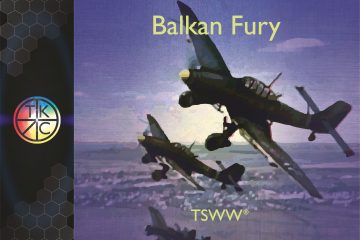TSWW Balkan Fury update… and more!
As you may have noticed I have gone a bit quiet – this is due to the vast chunk of work now being done on the final element of Balkan Fury – its at start booklet. This is not a small task, but 11 modules are now in the booklet – ranging from small naval encounters to full blown, multi year campaigns.
All good so far on this front, although I need to work up various elements for each of these modules and scenarios, especially the victory conditions. I am also reading a lot (that is work whether I like it or not) and have been buried in a book called “Luck was Lacking, Valour Was Not” published by Osprey, alleging to provide a more accurate look at the Italian war effort in North Africa. This in my view is a crock. It is a badly proofed book which is internally inconsistent, making statements like “Italian training is brilliant” and then countering that with “Italian training was awful”. Which is right?
As Mare Nostrum 2 is fundamentally a massive expansion of Balkan Fury (!) I felt it was a good time to start at least getting a feel for new research that has appeared over the past 10 years since we released Mare Nostrum the first-time round. Much of it is a regurgitation, and where this is not the case, it is an attempt to revise or at least put right the record as to various forces performance during the North African campaign.
Ranting now starts as you can imagine as we have spent a LOT of time looking at this already. In the revisionist texts, the general claim is that the Italians were great, the Germans perfidious, the British useless, and the Americans merely an adjunct to the overall outcome. To be 100% clear, these are fallacious views. No one force was perfect, and all had major issues to try and overcome to succeed. The view however, that the Italians are wonderful, is seriously misguided.
They were in fact by far the weakest of the major players in the desert war. The reasons for this are simple to note:
- The Italian military had not fully modernised due to a lack of money to build enough modern weapons to properly equip their forces. This doomed Italian troops to fight with not enough good weapon systems, and even when provided with older weapons, all too often not enough of them.
- Italian unit structures. Italy under Mussolini was paranoid. That is fairly typical of dictatorships as a whole, but he took it to weird new levels in some ways. He wanted a bigger army but would not pay for it – so, based on another set of fears – in effect a French and perhaps German trans-Alpine invasion, his senior generals gave him what he wanted… more divisions. This was done by gutting existing units from 3 to 2 regiments, and by reducing in many regards the total weapons fit in the divisions. We have good data on this from the Official History of the Italian military. We are also aware of strong evidence that shows that corps and army troops were also reduced in capability (say from 12 to 8 gun battalions – groups as they were known apparently) to match the expanded army structure. Obviously, the reduction in manpower and firepower placed the Italian army at a major disadvantage. With 36 guns, about the same number of mortars, and not more than 24 AT Guns, Italian infantry divisions were severely out gunned by German units (48 field weapons, plus 24 infantry guns, plus 27 AT guns, and many more mortars of all calibres being a typical infantry division load out), British units (72 field, at LEAST 48 anti-tank (usually 54 or 72 guns per division), 48 medium AA guns, and a large number of mortars). The US brought much the same mix of fire power to the table – and both the Allied powers added in significant army level firepower over time. Mobility in all competing armies was greater – the British were fully motorised, as were most (but not all) German and many US units in Africa.
- Italian armour, sold in the book noted above as a well balanced force had 3 armour (initially laughable L3 light tanks, eventually ok and then outclassed M13 or M14 medium tanks), 3 infantry, 1 AT, 3 Artillery battalions (later they got 2 “battalions” of Semoventes and about a battalion (read 24 semoventes, 12 81mm mortars) of mortars added – it’s a major plus up), 2 batteries of LAA, and 1 or 2 engineer companies. This compares directly with a German “many weapons, few men” “panzer” division in North Africa – they had 3 armour, 1 recce, 3 infantry, 1 AT, 1 AA, 1 engineer, and 3 artillery battalions – in short a bigger but realistically similar formation. British armour started out laughably weak in support – 6 armour battalions 1 or 2 of infantry, and artillery, with 1 battalion of recce, AA, AT, and Engineers attached to their divisions. By 1942, this was 3 armour, 4 infantry, 2 artillery, 1 recce, AA, AT and Engineer battalion (recognise that structure?). In short everyone did much the same thing. US “light” armour was the same in effect, whilst the “heavy” armour merely added another 3 armour battalions to their divisions. Balance is relative – the British thought their divisions were armour heavy. Rommel and Guderian thought they were about right as did the Italians. So this is not that far apart, but the problem is simple – the Italians do not have the volume of support assets inside their divisions, their tanks are comparatively weak, and they lack enough transport to properly supply the unit. Great they are not – brave they surely were.
- Italian logistical support was weak, partly due to German pilferage of their supplies, but mostly because the ports, naval capacity, and overall economic capacity, particularly the supply of POL was lacking. This meant that even although Italy, with an advanced motor transport industrial base, was not able to produce more vehicles. They could not fuel them. That was not noted in the book, but it is pretty clear from comments in other texts that conscious decisions NOT to motorise more were taken as a result of logistical and economic weakness. It becomes hard to defend the concept that the Italian army was “well equipped” in that light. It is harder to defend it when one considers that Giovanni Messi, arguably the only excellent Italian field commander, whilst in command of the CSIR in Russia asked for his units to be upgraded to mechanised or armoured status, with 3 combat and 1 artillery regiment, provided with the “most modern new Italian weapons” rather than his force be upgraded to an Army with 9 weak binary divisions. He was sacked. Mussolini sent the weak units and the rest became very unfortunate history for the Italian forces in 8th Army in the southern area of the Russian Front.
- Italian training was suspect in all too many areas. In short, whilst the professional officer “class” who went through the Italian military schools at least had a reasonable level of basic competence, the higher level training, and specialist training in the handling of mechanised forces was lacking until 1943 (the assumption being that the instigation of specialist training in mid 1942 took time to get results). Furthermore, the low quality of non-professional (ie what the British called hostilities only) officers was a direct result of inadequate professional training provided to them. Basic infantry and armour training for the ranks was lacking. This was so bad that training units were formed in the rear in Africa to teach inbound replacements HOW to drive, HOW to fire their guns etc. That is far from ideal, and whilst British and German replacements (and new units) often went through a process of training and habilitation to the climate and conditions of desert warfare, the Italians appear to have major problems in this regard over and above those suffered by their allies and opponents.
- Bravery was suspect. This is not necessarily true – indeed it takes monumental testicles to get into an Italian L3 type tankette and try and fight British units armed with AT guns that could kill them at range, whilst by 1942 the M14 series “medium” tanks (really just slightly heavy light tanks) were also suffering from exactly the same problem – they found it very hard to kill Allied AFVs and were outgunned both by many Allied tanks and every Allied AT Gun. Furthermore, referring to the failures of Italian logistics and modernisation, most Italian units (the infantry divisions in particular) were not motorised. Indeed they had a very low level of integral transport, and as such in a highly mobile war, were usually easily out manoeuvred. That lack meant surrender given the inability of the forces to either retreat or to be resupplied in situ. However, it should be noted on some occasions (not many) they fought very well and with great long term determination. More typical was the brave but idiotic and totally valueless sacrifices of Italian infantry in attacks on Tobruk in 1941 (about a division in its entirety surrendered or were killed during these attacks ordered by Rommel with Italian command consent). Time and again the Italians took massive losses in relation to those suffered by the defending troops, and this alone shows a lack of capability (albeit this is also absolutely normal in the German army – moving was fine, so was open warfare but as soon as the Germans got close to any form of siege warfare, they fell apart into failed, repetitive and largely unsuccessful human wave attacks).
- Italian commanders were excellent. Well, all you need to is look at some of the daft Italian operational decisions to dissuade yourself of that. It took real expertise in being useless to drive armour into known minefields (Tobruck, 1941, Gazala 1942) and to also manage to get encircled repeatedly (see mobility above for some of that problem but there are also foolish over reliance on the “honour” of the Nazi officer corps. The lack of drive at the top was a major issue for the Italians, and this resulted in Rommel being able, without major censure, to essentially ignore his allies when it suited his desire to either hog the limelight, or run like hell saving German lives at the expense of his Italian Allies.
- The Italian navy did their job in supplying Italian (and German) forces in North Africa. This is open to debate. Given the paucity of decent port facilities in Africa as a whole outside of British controlled Egypt, South Africa and East Africa, or French controlled Vichy North Africa, it is hard to see how, even had the Axis been able to run more or bigger convoys across the Mediterranean, they could have exploited the relative wealth of supply that was being sent! That said, the British in general sank a higher percentage of Axis shipping enroute to Africa than the vaunted U-boats sank anyplace during their guerre-de-course against British (and then Allied) naval supply lines. With 5-25% of Axis supplies and reinforcement sunk (usually manpower survived but equipment and supplies did not) enroute, the impact was severe, often at key points. At the worst, the German (and to a much lesser extent) Italian submariners operating in the Atlantic Basin, Indian Ocean and the Caribbean Ocean managed to inflict a maximum of 5% losses. In the Arctic, and in the Mediterranean, loss rates peaked at times at 75% of despatched shipping being lost (independent sailings to Russia were disastrous, whilst the loss at sea or after arrival of merchant ships at or going to Malta rose to horrendous proportions), but all that said, at no point was the Axis able to stop Allied operations through supply problems caused by losses in transport to the theatre. The British (for the most part – US assets took part in 1943) did manage this at times. All that said, the Regia Marina fought a tough, uncompromising naval war to force through supply convoys, and did a creditable job of doing so in the face of far superior Allied forces. Superiority was not in numbers, but in training, technology, esprit de corps, and in sheer naval fighting tradition and experience. The RN massacred Italian forces repeatedly at night, and got away with ridiculously risky engagements during day time, time and again. So, did the Italian navy do a great job? Probably not – but they did a decent job!
- The Italian airforce is hard done by in history. Well yes and no. Yes, because their bomber crews attacked time and again into the buzz saw of Anglo American AA defences, taking on average 50% losses every time they did this. Amazing heroism, shown by the large number of Italian Gold Medals (their equivalent of the VC or Medal of Honour) won by bomber crews assigned to naval strike missions. Their dive bomber crews did very well – and their fight pilots when flying a decent plane were just as good as anyone else at aerobatics. Sadly, they could not navigate (they were not trained in navigation), were not trained in air to air combat techniques, and often had to fly older, less competitive planes. Furthermore, Italian aero engine companies could not provide a decent high performance engine, thus relegating outstanding plane designs to the “too little, too late” category. This meant that the Italian air force was always on the back foot, and was unable to properly provide support for the Italian Army, and as vitally, the Italian Navy (which was told by Mussolini – back to paranoia – to run away from British carrier based planes…. Despite these usually being obsolescent bi-planes or where these exceptional antiques were present, were lacking in vast numbers) thus condemning those aggressive Italian commanders to running away, even where they felt they could (and should) press the engagements.
I could go on – Italian military effort in WW2 was a curate’s egg. Good in parts. Usually average, often rubbish and sometimes, Decima MAS being one classic example, outstanding. We show these capabilities in different ways in the TSWW system. Special forces are just that – special, with special capabilities. The superb fighting units like Trieste, Folgore, Ariete, Giovanni Fascisti, San Marco, Julia and so on are averaged down to uprate the really rubbish units like the CCNN divisions and the North African garrison divisions like Catanzaro and Sabratha (which was not that bad to be fair).
It is hard to criticise an encircled garrison, taken under fire by the artillery of the Mediterranean Fleet (its main battle line), the bulk of the nascent desert air force, and 1.5 divisions of “British” (actually mostly Australian) troops for surrendering once their water supply was destroyed or captured, but when this happens time and again in 1940-41, and again in 1942, you have to ask why? Some (but not all) of the reasons are above….
More soon!



0 Comments